Human Orbital Spaceflights
![]()
International Flight No. 237Soyuz TMA-3IngulRussia |
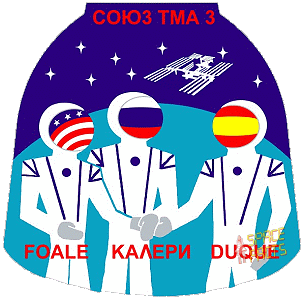 |
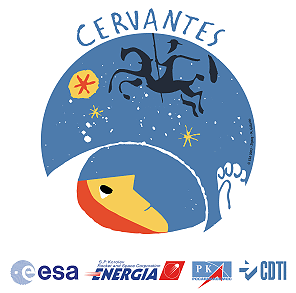 |
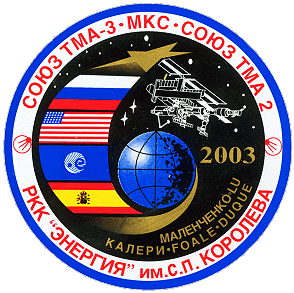 |
||
![]()
Launch, orbit and landing data
walkout photo |
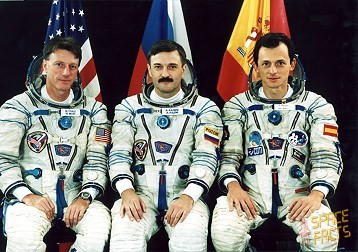 |
|||||||||||||||||||||||
alternative crew photo |
alternative crew photo |
|||||||||||||||||||||||
alternative crew photo |
alternative crew photo |
|||||||||||||||||||||||
alternative crew photo |
||||||||||||||||||||||||
Crew
| No. | Surname | Given names | Position | Flight No. | Duration | Orbits | |
| 1 | Kaleri | Aleksandr Yuriyevich | Commander | 4 | 194d 18h 33m 12s | 3054 | |
| 2 | Duque | Pedro Francisco | Flight Engineer | 2 | 9d 21h 02m 17s | 155 | |
| 3 | Foale | Colin Michael | Flight Engineer | 6 | 194d 18h 33m 12s | 3054 |
Crew seating arrangement
|
 |
|
||||||||||||||||
Backup Crew
|
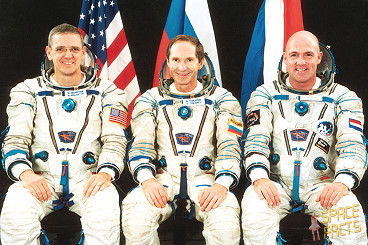 |
||||||||||||||||||||
alternative crew photo |
|||||||||||||||||||||
alternative crew photo |
Hardware
| Launch vehicle: | Soyuz-FG (No. 15M132S D15000-007) |
| Spacecraft: | Soyuz TMA-3 (TMA No. 213) |
Flight
|
Launch from the Baikonur Cosmodrome and
landing 59 km northeast of Arkalyk. Soyuz TMA-3 carried the ISS Expedition 8 The mission was called a "caretaker" crew. Following a two-day solo flight Soyuz TMA-3 docked to ISS on October 20, 2003. Aleksandr Kaleri and Michael Foale replaced the Expedition 7 crew. Pedro Duque performed some ESA sponsored science experiments under the mission name Cervantes and then returned with the ISS-7 crew on Soyuz TMA-2. Progress M1-11 was launched at 11:58:08 UTC on January 29, 2004. The spacecraft docked with the Aft port of the Zvezda module at 13:13:11 UTC on January 31, 2004. Progress M1-11 carried supplies to the International Space Station, including food, water and oxygen for the crew and equipment for conducting scientific research. Its cargo included an Orlan spacesuit, a replacement flex hose for the Destiny module, a new Elektron oxygen generator with spare parts for the Elektrons already aboard the ISS, some oxygen generator candles, spare batteries, new fire detection and suppression systems, a gas analysis system, cameras, data cassettes, and an external experiment package for the Zvezda module, Matryoshka. It was also used to perform a reboost maneuver shortly before its departure from the ISS. It remained docked for four months before undocking at 09:19:29 UTC on May 24, 2004 to make way for Progress M-49. Following undocking, it remained in orbit for ten days, conducting tests of its attitude control system. It was deorbited at 09:50 UTC on June 03, 2004. The spacecraft burned up in the atmosphere over the Pacific Ocean, with any remaining debris landing in the ocean at around 10:36:25 UTC. The only EVA in this mission was performed by Michael Foale and Aleksandr Kaleri on February 26, 2004 (3h 55m) to install new experiments and replace and remove parts for existing experiments on the exterior of the ISS. The EVA was shortened due of cooling problems with Aleksandr Kaleri's space suit. Michael Foale and Aleksandr Kaleri were able to complete a number of their tasks. The first task was the replacement of cassette containers that hold sample materials for an experiment studying the effect of long-duration exposure to the microgravity environment. Later, Michael Foale replaced two similar cassettes housed on the outside of the Zvezda Service Module. A Russian experiment named Matryoshka was attached to the outer hull of Zvezda which will provide data on radiation exposure to the human body during space flight. The spacewalkers also removed one of the suitcase-sized devices associated with the Japanese Aerospace Exploration Agency's MPAC-SEEDS experiment. They relocated a second device. This experiment was studying micro-meteor impacts and material exposure in the space environment. This experiment was installed on the ISS by Expedition 3 spacewalkers October 15, 2001. The crew was not able to complete the removal of laser light retroreflector devices from the aft end of Zvezda. The reflectors were being studied as navigation devices for the European Space Agency's Automated Transfer Vehicle, which first flew to the ISS in 2008. Another task not included was work on a materials science experiment called Kromka. This experiment measured the amount of residue emitted from Zvezda's jet thruster firings. The crew conducted the first two-person spacewalk at the International Space Station. Unlike previous spacewalks conducted by ISS crews, there was not a crewmember inside the Station as the spacewalkers worked outside. The spacewalk was based out of the Pirs docking compartment. The spacewalkers wore Russian Orlan space suits. Among other repair work the crew later repaired successful a treadmill and an oxygen producing Elektron unit aboard the ISS. The crew also performed all in all 27 experiments on different scientific fields. The Soyuz spacecraft is composed of three elements attached end-to-end - the Orbital Module, the Descent Module and the Instrumentation/Propulsion Module. The crew occupied the central element, the Descent Module. The other two modules are jettisoned prior to re-entry. They burn up in the atmosphere, so only the Descent Module returned to Earth. The deorbit burn lasted 255.8 seconds. Having shed two-thirds of its mass, the Soyuz reached Entry Interface - a point 400,000 feet (121.9 kilometers) above the Earth, where friction due to the thickening atmosphere began to heat its outer surfaces. With only 23 minutes left before it lands on the grassy plains of central Asia, attention in the module turned to slowing its rate of descent. Eight minutes later, the spacecraft was streaking through the sky at a rate of 755 feet (230 meters) per second. Before it touched down, its speed slowed to only 5 feet (1.5 meter) per second, and it lands at an even lower speed than that. Several onboard features ensure that the vehicle and crew land safely and in relative comfort. Four parachutes, deployed 15 minutes before landing, dramatically slowed the vehicle's rate of descent. Two pilot parachutes were the first to be released, and a drogue chute attached to the second one followed immediately after. The drogue, measuring 24 square meters (258 square feet) in area, slowed the rate of descent from 755 feet (230 meters) per second to 262 feet (80 meters) per second. The main parachute was the last to emerge. It is the largest chute, with a surface area of 10,764 square feet (1,000 square meters). Its harnesses shifted the vehicle's attitude to a 30-degree angle relative to the ground, dissipating heat, and then shifted it again to a straight vertical descent prior to landing. The main chute slowed the Soyuz to a descent rate of only 24 feet (7.3 meters) per second, which is still too fast for a comfortable landing. One second before touchdown, two sets of three small engines on the bottom of the vehicle fired, slowing the vehicle to soften the landing. During the stay on board of the ISS the crew of Expedition 8 carried out the following scientific experiments: Actin (Role of Weightlessness on Metabolism), ADUM (Advanced Diagnostic Ultrasound in Microgravity), ARISS (Amateur Radio on the International Space Station), BCAT-3-4-CP (Binary Colloidal Alloy Test - 3 and 4: Critical Point), BCAT-3-BA (Binary Colloidal Alloy Test - 3: Binary Alloys), BCAT-3-SC (Binary Colloidal Alloy Test - 3: Surface Crystallization), Biodegradation (Initial stage of Biodegradation and Biodeterioration in Space), Bioekologia (Generation of High Efficiency of Microorganisms for the Production of Preparations of Biodegradable Oil, Organophosphorus Material, Measures for the Protection of Plants, as well as, of Exopolysaddharides Uses in the Petroleum Industry), Biorisk (Influence of Factors of the Space Environment on the Condition of the System of Microorganisms-Hosts Relating to the Problem of Environmental Safety of Flight Techniques and Planetary Quarantine), Biotest (Biochemical Status of Humans in Long Duration Space Flight), Brados (Acquisition of Data About the Radiological, Electromagnetic and Different Physical Environments on Board ISS, and Their Effects on the Safety of the Crew, Space Equipment and Materials), Caf (Crystalization of th Protein Caf1M and its Combination with the Terminal Peptide Caf1 as the Elements for the Development of a New Generation of Antimicrobial Medicinal Preparations and Components of Vaccines from Yeasts), Cardio-ODNT (Dynamics of the Main Factors of Cardiac Function, of Central and Regional Circulation in Rest and During the Influence of Lower Body Negative Pressure), CBOSS-FDI (Cellular Biotechnology Operations Support Systems: Fluid Dynamics Investigation), CEO (Crew Earth Observations), Chromosome-1 (Chromosomal Aberrations in Blood Lymphocytes of Astronauts-1), Clinical Nutrition Assessment (Clinical Nutrition Assessment of ISS Astronauts, SMO-016E), Diatomeya (Stability of Geographical Position and Configuration of Borders of Bioproductive Water Zones of the World Oceans, Observations by Orbition Station Crews), Diurez (Fluid and Electrolyte Metabolism and Hormonal Regulaltion of Fluid Volume), EarthKAM (Earth Knowledge Acquired by Middle School Students), Environmental Monitoring (Environmental Monitoring of the International Space Station), EPO (Education Payload Operations), EPO-Demos (Education Payload Operation - Demonstrations), ETD (Eye Tracking Device), Farma (Characteristics of Pharmacological Responses (absorption, distribution and elimination of acetominophene) in Long Duration Space Flight), Foot (Foot Reaction Forces During Space Flight), Gematologia (Morphofunctional Characteristic of Blood Cells and the Intensity of Erythropoiesis in Humans by the Influence of Factors of Space Flight), Heart (Physiological Parameters that Predict Orthostatic Intolerance After Spaceflight), HPA (Hand Posture Analyzer), ICE-First-Aging (International Caenorhabditis elegans Experiment First Flight-Aging), ICE-First-Apoptosis (International Caenorhabditis elegans Experiment First Flight-Apoptosis), ICE-First-Cells (International Caenorhabditis elegans Experiment First Flight-Cells), ICE-First-Development (International Caenorhabditis elegans Experiment First Flight-Development), ICE-First-Genomics (International Caenorhabditis elegans Experiment First Flight-Genomics), ICE-First-Muscle Proteins (International Caenorhabditis elegans Experiment First Flight-Muscle Proteins), ICE-First-Radiobiology (International Caenorhabditis elegans Experiment First Flight-Radiobiology), Identifikatsia (Identification of the Sources of Dynamic Loads on ISS), Inflight Education Downlinks (International Space Station Inflight Education Downlinks), Interactions (Crewmember and Crew-Ground Interaction During International Space Station Missions), Interleukin-K (Production of Hight Quality Crystals of Interleukin -1Alpha, -1Beta and Receptor of Antagonist of Interleukin-1), Iskazheniye (Determination and Analysis of Magnetic Interference on ISS), ISSI (In Space Soldering Investigation), ISS Acoustics (International Space Station Acoustic Measurement Program), Izgib (Effect of Performance of Flight and Science Activities on the Function of On-Orbit Systems on ISS (Mathematical Model)), JAXA-GCF (Japan Aerospace and Exploration Agency - Granada Crystallization Facility High Quality Protein Crystallization Project), Journals (Behavioral Issues Associated with isolation and Confinement: Review and Analysis of Astronaut Journals), Kromka (Verification of the Effectiveness of Devices for the Protection of the Exterior Surface of ISS from Contaminants Deposited by Pulsed Cycling of Liquid-Jet), Meteoroid (Recording Meteoroidal and Technogenic Particles on the External Surface of the Service Module of the Russian Segment of ISS), Mezhkletochnoe Vzaimodeistvie (Intercellular Interactions in Space Flight), MFMG (Miscible Fluids in Microgravity), Mimetik-K (Crystalization of antigen Binding Fragment of Monoclonalical Antibody to Glucosaminilmuramildepeptide), MISSE-1 and 2 (Materials International Space Station Experiment - 1 and 2), Mobility (Promoting Sensorimotor Response Generalizability: A Countermeasure to Mitigate Locomotor Dysfunction After Long-Duration Space Flight), Molniya-SM (Investigation of Lightning Discharges in the Earth's Atmosphere and Lower Ionosphere), MOP (Motion Perception: Vestibular Adaptation to G-Transitions), MSK (Cultivation of Mesenchymal Stem Cells From Bone Marrow in Space Flight), Muscle (Study of Low Back Pain in Crewmembers During Space Flight), Paradont (Condition of Peridontal Tissues in Space Flight), PCG-STES-RGE (Protein Crystal Growth-Single Locker Thermal Enclosure System-Regulation of Gene Expression), PCG-STES-SA (Protein Crystal Growth-Single Locker Thermal Enclosure System-Science and Applications of Facility Hardware for Protein Crystal Growth), PFMI (Toward Understanding Pore Formation and Mobility During Controlled Directional Solidification in a Microgravity Environment), Pilot (Individual Characteristics of Psychophysiological Regulatory Status and Reliaility of Professional Activities of Cosmonauts in Long Duration Space Flight), Plasma Crystal (Dusty and Liquid Plasma Crystals in Conditions of Microgravity), Platan (Search for Low Energy Heavy Particles of Solar and Galactic Origin), Privyazka (Development of High Precision Orientation of Scientific Devices in Space with Reports of Deformation of the ISS Hull), Profilaktika (Mechanisms of Action and Influence, and Effectiveness of Various Methods of Phrophylaxis Directed Toward Prevention of Disturbances of the Human Locomotion System in Weightlessness), Prognoz (Development of a Method of Operational Prediction of Work Load on Crew Piloting Objectives), Pulse (Vegatative (Autonomic) Regulation of the Cardio-Respiratory System of Humans in Conditions of Weightlessness), Rastenia (Growth and Development of Higher Plants through Multiple Generations), Relaksatia (Processes of Relaxation in the Ultraviolet Band Spectrum by High Velocity Interaction of Exhaust Products on ISS), Renal Stone (Renal Stone Risk During Spaceflight: Assessment and Countermeasure Validation), Sample (Study of Microbial Communities Exposed to Weightlessness), Seeds (Seeds in Space), SKR (Skorpion: Development and Acquisition of Multifunctional Control-Measurement Device for Controlling the Environment of Scientific Experiments Inside a Pressurized Station), SPHERES (Synchronized Position Hold, Engage, Reorient, Experimental Satellites), Sprut-MBI (Determination of Intracellular and Extracellular Fluid Volume in Humans in Space Flight), Subregional_Bone (Subregional Assessment of Bone Loss in the Axial Skeleton in Long-term Space Flight), Tenzor (Definition of Dynamic Characteristics of ISS), Toksichnost (Development of a Metod of Express Monitoring of Toxicity of Water in Space Flight), Uragan (Hurricane: Experimental Development of Groundbased System of Monitoring and Predicting the Progression of a Naturally Occurring Technogenic Catastrophe), Vaktsina-K (Structural Study of Protein Candidats in a Vaccine for AIDS on Earth and in Space), Vektor-T (Study of a High Precision System for Prediction Motion of ISS), Yeast-GAP (Yeast-Group Activation Packs). |
EVA data
| Name | Start | End | Duration | Mission | Airlock | Suit | |
| EVA | Foale, Michael | 26.02.2004, 21:17 UTC | 27.02.2004, 01:13 UTC | 3h 56m | ISS-08 | ISS - Pirs | Orlan-M No. 14 |
| EVA | Kaleri, Aleksandr | 26.02.2004, 21:17 UTC | 27.02.2004, 01:13 UTC | 3h 56m | ISS-08 | ISS - Pirs | Orlan-M No. 23 |
Note
Photos / Graphics
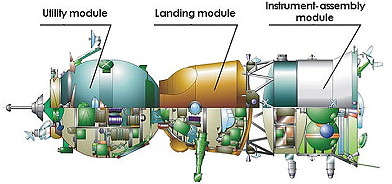 |
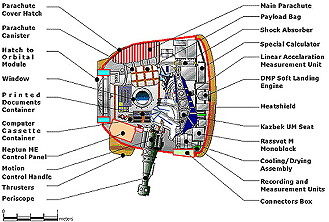 |
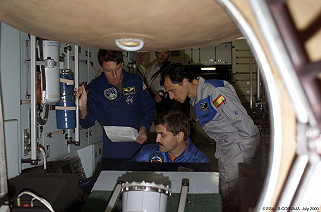 |
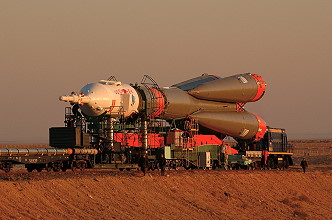 |
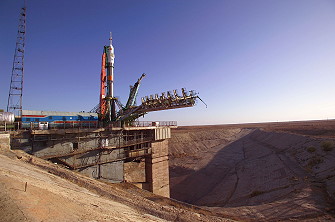 |
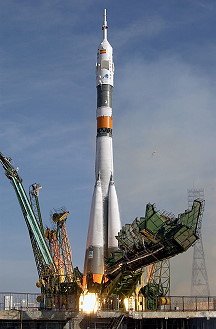 |
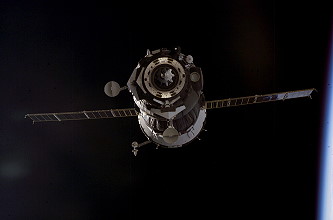 |
 |
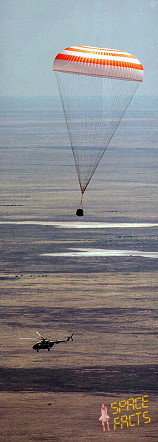 |
 |
| © |  |
Last update on March 29, 2020.  |
 |